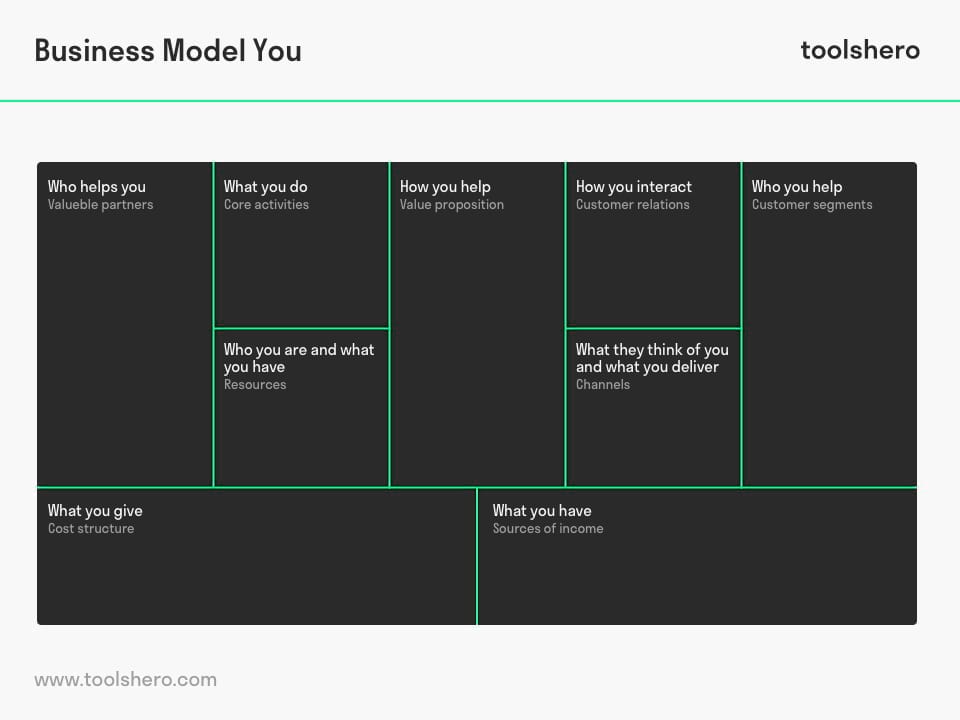Business Model You (BMY)

Business Model You (BMY): this article provides a practical explanation of Business Model You (BMY). Next to what it is, this article also highlights the structure and building blocks with an example of the Business Model You canvas, the four parts of the process (step-by-step plan) and a downloadable Business Model You template to get started. Enjoy reading!
What is Business Model You?
Business Model You (BMY) is based on the Business Model Canvas from the book Business Model Generation. Business Model Generation – a global best seller – introduced Business Model Canvas as a unique and visual methodology to summarise any organisation or idea, brainstorm about it, and explore in detail on just a single sheet of paper.
BMY uses this same piece of paper; the nine building blocks of a business. However, it applies it to the personal living and working environment of an individual. This canvas teaches users to draw personal business models that can reveal new ways to get more out of themselves based on skills and changing market demands. The goal of Business Model You is to launch or give shape to new, gratifying careers.
The Business Model Canvas method has grown into the world’s leading and best known description of a business model. The book visually demonstrates how business-model-thinking works and how organisations are structured on the basis of nine simple building blocks. This helps them to chart their own personal business model.
When combined with the BMY, this ensures users understand the value of their own skills in the job market, and how they can use these to determine their personal goals. A combination of Business Model Canvas and Business Model You enables the user to develop a groundbreaking vision for his life, both on a professional and private level.
The idea to use the Business Model Canvas for individuals came from Timothy Clark, and not exactly on a whim either. Timothy Clark had over forty jobs and was the driving force behind the initiative to adapt the existing model.
He did so together with Alex Osterwalder and Yves Pigneur. When he was 51, he graduated university and became a professor at Tsukuba University in Tokyo.
Business Model You : structure and building blocks
Tim Clark innovated the Business Model Canvas to make it useful for planning complex career decisions. The Business Model You helps with complex quandaries when the user wishes to make changes to their career. It does so by focusing on a person’s talents, goals, needs, desires, and environment.
Like the Business Model Canvas, the BMY also consists of nine valuable elements:

Figure 1 – an example of teh Business Model You Canvas
1. Who helps you – valuable partners
Making important career decisions is something that needs to be done in a very careful and considered way. In order to be able to justify one’s choice in the future, it’s a good idea to get advice from others.
The people who help you with this are the first – and highly important – building block of the BMY Examples of people who help with making choices are often the people who are close to someone, people like family, friends, superiors, mentors, etc.
2. What you do – core activities
The next step in the BMY is determining and writing down what the user does exactly. This is important information to potentially argue and motivate why a job change is a good idea.
It might turn out that the current job description doesn’t use the right talents, or that other positions might have more to offer in terms of personal development.
The big question that needs to be answered here is: What do I do? Which activities determine what my job looks like? For instance, is my focus on designing, teaching, managing, planning, or calculating?
3. How you help – value proposition
How you help refers to the specific value an employee adds. Does the employee help solve a particular problem for the employer or consumer? How does the employee help achieve goals for the consumer or employer?
The value proposition is an important part of both Business Model Canvas and BMY. The value that an employee adds to a goal directly influences their motivation and level of involvement they experience. Write down action sentences, such as: I contribute to reducing risks, building a strong brand, etc.
4. How you interact – customer relations
The way in which people communicate with others – such as employers or consumers – is often the reason for unhappiness. It is therefore important to note down any form of communication here. What kind of relationship do people have with the boss, and how do they communicate with employees? Does the communication mostly take place through online media, or is there a more personal approach?
5. Who you help – customer segments
Who you help says something about the type of organisation that might benefit from the work of a certain future employee. Here you write down the organisations you think you can contribute to applying your strengths.
6. Who you are and what you have – resources
This building block of the BMY is where the user has to write down his identity in the context of his career goal using some keywords. What are my talents? What type of work do I enjoy? What type of work makes me feel I’m making a difference? Which resources have helped me achieve my career goals?
7. What they think of you and what you deliver – channels
This seventh building block is about networks and reputations. When looking for a new job, it’s important to be visible. How can potential employers or clients recognise you and contact you? Am I active on different social media? How can they hire me, and how do I offer my services? How do I ensure that my employer is satisfied with my performance? In this seventh building block, create an overview of everything related to communication, networking, and visibility.
8. What you have – sources of income
Income is often a crucial factor when deciding whether or not to change careers. Although we know monetary compensation is only part of what motivates an employee, it is certainly necessary that the employee is paid fairly.
In this eighth building block you look at what you’re paid, what you’re paid for, whether you’re satisfied with this, how much you would like to be compensated by your next employer, and whether or not you’ll enjoy any other, non-monetary benefits.
9. What you give – cost structure
The eighth building block is about determining income. The ninth and final building block is about expenses, but in a non-monetary sense.
Which expenses or costs are involved with carrying out your work – such as time, your commute, stress, energy, etc. Decide whether you are happy with this or if there are things you would like to arrange differently with you next employer.
Business Model You: four parts
The BMY describes an effective four-step method to draw personal business models that enable individuals to adjust themselves and their vision in the search for new job ideals. Generally speaking, the book is divided into the following four parts
1. the Business Model You Canvas
The first part explains in greater detail what a business model is exactly, what business model thinking is, what a personal Canvas business model is, and how the user can take the lead to arrive at a valid and considered decision.
2. Reflect
In his book, Tim Clark offers a wide range of opportunities for reflection. One of these is the BMY model with the nine building blocks. It can be downloaded freely in this article. Fill out this model will help you reflect on your personal environment.
3. Revise
The more of these reflections you fill out, the more you’ll learn about what goes on and what opportunities there are in professional life. Together with the reflections, the user then has to fill out the personal BMY model again, although now from this new perspective.
4. Act on your new Business Model You Canvas
In the final part, Tim Clark asks the reader to try out the new personal BMY model in practice. One important aspect to this is determining one’s personal business value.
How can the user benefit a future employer, and how much should he be paid for this? Based on the personal BMY model, the user is supported – by means of useful personal insights – on the path towards a career that will sufficiently satisfy him.
Business Model You template
Now that you’ve read about BMY model, you’re ready to conduct your own analysis with our Business Model You template.
Download the Business Model You template
This template is exclusively for our paying Toolshero members. Click here to see if a membership is something for you!Now it’s your turn
What do you think? Are you familiar with the explanation of BMY? How would you use this article when making a decision about a potential career switch? What are some of essential aspects to consider when making an important decision like this? Do you have any tips or additional comments?
Share your experience and knowledge in the comments box below.
More information
- Clark, T., Osterwalder, A., & Pigneur, Y. (2012). Business Model You.
- Osterwalder, A., & Pigneur, Y. (2010). Business model generation: a handbook for visionaries, game changers, and challengers. John Wiley & Sons.
How to cite this article:
Janse, B. (2019). Business Model You (BMY). Retrieved [insert date] from Toolshero: https://www.toolshero.com/personal-development/business-model-you/
Published on: 03/14/2018 | Last update: 11/08/2023
Add a link to this page on your website:
<a href=”https://www.toolshero.com/personal-development/business-model-you/”>Toolshero: Business Model You (BMY)</a>












